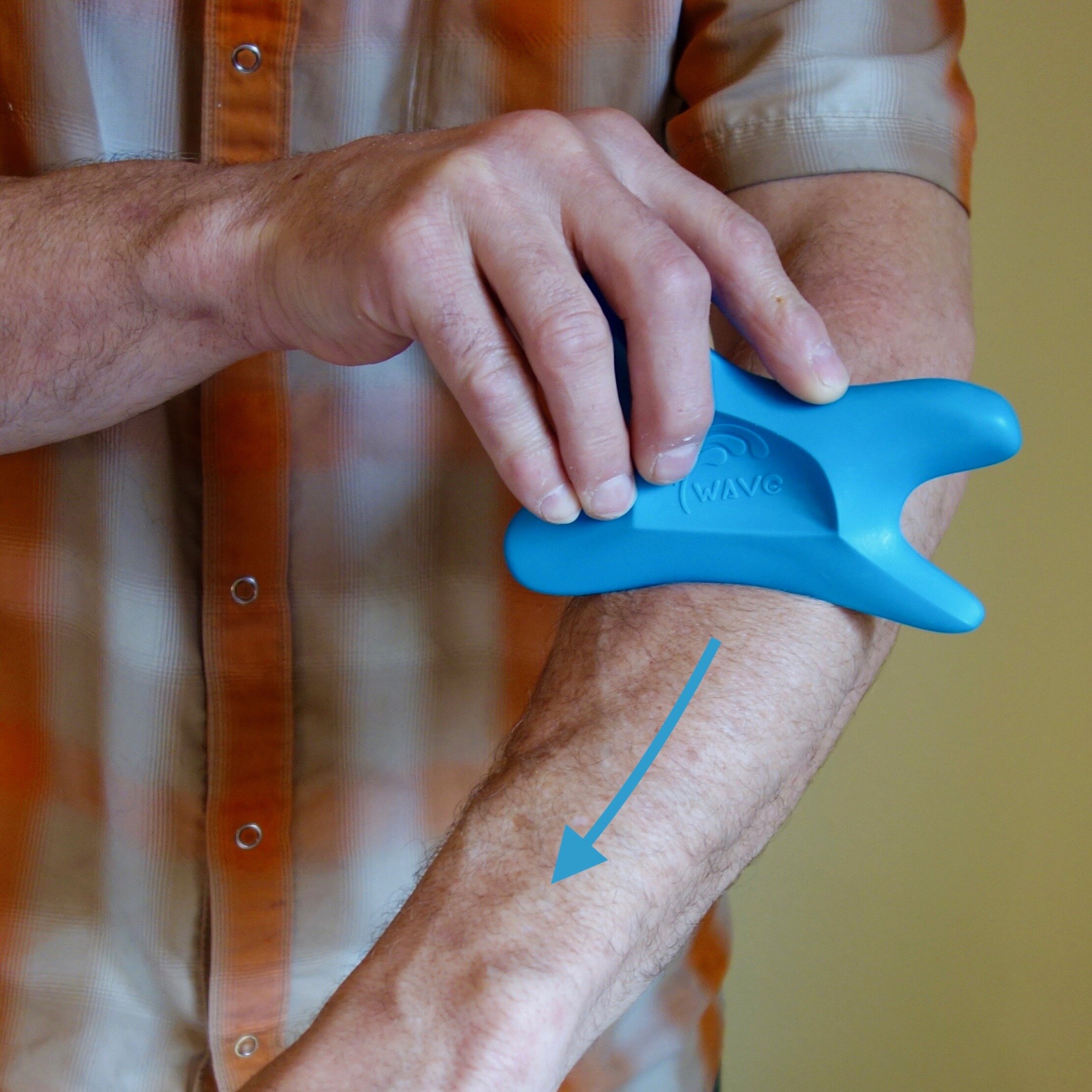How to Release Tight Forearm Muscles with the Wave Tool

Jeff Giddings, PT https://www.frontrangeclimbingpt.com/
Reposted from CLIMBING.com
https://www.climbing.com/skills/how-to-release-tight-forearm-muscles-using-the-wave-tool/
Climbing places tremendous loads on the muscle and tendon structures in our hands, forearms, and elbows. Overuse, inadequate recovery time, poor form, and fatigue can lead to strain of these muscles and tendons. Symptoms of overuse strain begin to manifest as muscle soreness and the development of trigger point pain and tightness. Trigger points are taut areas of muscle tissue that are unable to relax back to their resting state. Chronic trigger points can be very painful, and they can begin to inhibit your climbing progress and even lead to increased strain and tension to the tendon attachment points at your elbow.
Management of these tight muscles is very possible with a proper exercise regime and with use of your Wave Tool. The Wave Tool has a myriad of edge designs and shapes that can be used to effectively scrape and massage the entire muscle and tendon complex.
I recommend doing the Wave or any scraping and massage recovery regimen 15-20 hours after a hard climbing or training session. The entire bodywork session should last about 10 minutes. Add a little more time if it’s feeling good or decrease the treatment duration if you’re short on time or feeling very sore. Persistent soreness that does not resolve with this program may warrant a visit to your Medical Professional.
Here’s how to do it:
For maximum effectiveness and comfort when using an edge tool, you should use lotion. Any good skin lotion should work well or for added benefit use a muscle recovery balm.
Begin with the large blade or “Scraping” edge on the Wave Tool. The scraping edge is made to release facial adhesions that may have formed between the muscle fibers and facial envelope. This edge is also a nice way to positively stimulate the nervous system and decrease areas of sensitivity and tension. Use long broad strokes with the edge held at a 45-degree angle, like you are plowing snow (pushing) with the edge. Perform 10 strokes from the inside of your elbow down to the wrist. Now perform 10 strokes the opposite direction from your wrist up to the elbow. Now turn your palm down and do the same 10 strokes in both directions from the outer elbow down to the back of your hand. The strokes should be firm but comfortable and the speed should be such that it takes two seconds to travel the distance from elbow to hand.
Next, we want to find and treat the trigger points or any other areas of tension within the muscle. The trigger points will be more tender then the surrounding tissues and the muscle tissue will feel tight. Once you have found a trigger point use the trigger point knob or pressure disc of your Wave Tool to apply deep and steady pressure. Hold this pressure with the tool and take 5 deep breaths in through your nose and out through pursed lips. As you exhale you can slightly increase the pressure. Repeat this process throughout the inside and outside forearm muscles.
Now go back to any trigger points or tight spots that were especially tender. Apply the same pressure using the trigger point knob and now slowly and gently move your wrist from full flexion into full extension. Keep steady pressure with the Wave Tool as you move the wrist back and forth. Perform 5 full wrist movements and repeat with any other tender areas.
After the trigger points are released, they can expel chemical waste products that build up with the chronic muscle contraction. It is extremely helpful to flush out these chemicals and to move blood and lymph throughout the muscle tissues. For this, use the rounded massage surface on the Wave Tool. Perform 10 or more strokes with the massage surface from the wrist up towards the elbow and another 10+ strokes from the back of your hand towards the outer elbow.
Your forearms should feel relaxed and comfortable following the treatment session. If you are experiencing chronic pain and soreness at the elbows, this can indicate a tendinitis or tendinopathy condition. You will need more specialized care for these problems.
